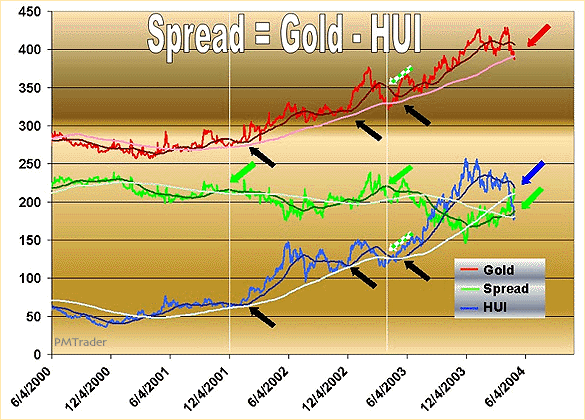The HUI Spread
in the Golden Bull
PMtrader
May 3, 2004
A brief
discussion which quantifies the spread in the HUI follows. This
work builds on several prior essays, primarily the one entitled
"Finding Leverage in the HUI," which can be found
here. The "spread"
as defined in this paper is given by the price of gold minus
the value of the HUI index. The question to be answered is very
simple; "Do the unhedged mining shares provide a leading
indicator for the price of gold?" Note that if they do,
then they also give a clue as to their own future performance,
as their fate is inextricably linked to the price of gold. Before
proceeding, a word about the data set is warranted. I used the
values for ^GLDD on Yahoo to represent the price of gold and
the values of ^HUI as representative of the unhedged shares.
The period of consideration is from June of 2000, through April
of 2004. This latter period was chosen so as to fully encapsulate
the current and ongoing bull market in gold.
Now let's get started by looking at an annotated plot. Three
primary sets of daily data are given: Gold, Spread, and the HUI.
Each primary data set has an associated fifty day (darker primary
color) and two-hundred day (lighter primary color) moving average.

First, note
the two vertical light-colored lines. They pass through peaks
in the 50 dma for the spread (dark green line) - representative
of when the mining shares are underperforming the price of gold
to a locally maximum extent. These peaks in the 50 dma for the
spread were arguably the best buy points in the entire gold bull
so far. Further, there were very few false positives given by
this "norm."
Something else is of interest. If you look at the right most
vertical line, arrows (white dotted with green) are drawn where
the line intersects both the Gold and the HUI data sets. These
two data sets normally issue possible buy signals when the 50dma
is closest to the 200 dma (black arrows), whereas the Spread
data set issues buy signals when the 50 dma is furthest away
from the 200 dma (green arrows). The thing of interest is that
the Spread analysis gave a buy signal more than a month before
the Gold and HUI direct analysis. Further, there were significantly
fewer false positives from the Spread analysis as previously
mentioned.
Now, consider the right most arrows for all three respective
data sets. From top to bottom these arrows are red, blue, and
green, corresponding to the colors of the respective primary
data sets. There is only one conclusion that I can draw from
the relative performance of all three plots. If this gold bull
has life left in it - and the fundamentals tend to scream that
it does - we are fast approaching another great buy point in
the "Progression of the Golden Bull." The bottom line - it is probable that the next
leg up in the HUI will be foreshadowed by a new return to an
out performance of the mining shares, as characterized by a local
peak in the 50 dma for the spread.
As a final note, I want to talk about a trend that is becoming
visible in the Spread data - it appears to be downward sloping.
This fact is very bullish for the unhedged mining shares in the
long term as it implies that as gold approaches 500, the HUI
index will likely approach 350 - as opposed to 300, which is
implied by the "Rule of 200" introduced in the prior
referenced essay. A detailed analysis of this new trend will
be given in a subsequent discussion.
May 3, 2004
PMtrader
email: PMtrader
Copyright ©2004 by Author
- Reproduced with Permission.
 About Terry L. Krohn About Terry L. Krohn
Mr. Krohn is a research scientist living in the Washington D.C.
area.
His field of expertise is scattering physics - the analysis of
interactions between electro-magnetic waves and matter.
321gold Inc

|


 About Terry L. Krohn
About Terry L. Krohn